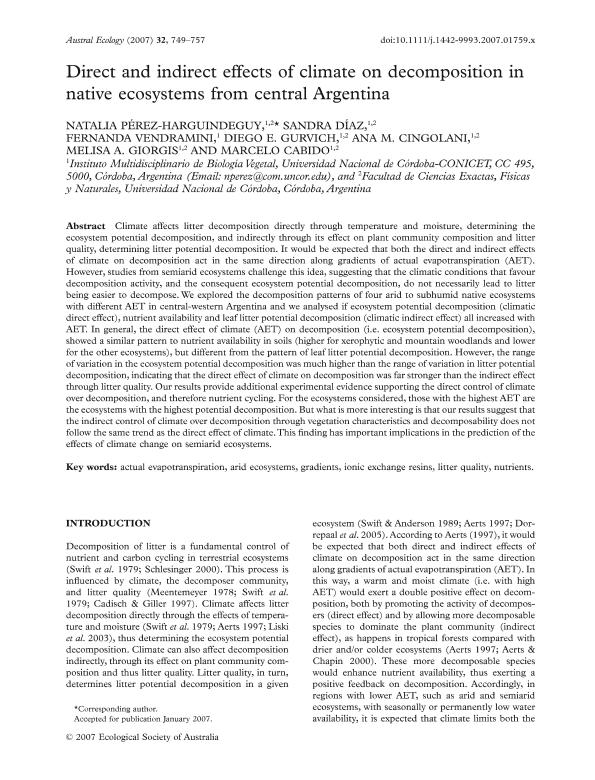Mostrar el registro sencillo del ítem
dc.contributor.author
Pérez Harguindeguy, Natalia

dc.contributor.author
Díaz, Sandra Myrna

dc.contributor.author
Vendramini, Fernanda
dc.contributor.author
Gurvich, Diego Ezequiel

dc.contributor.author
Cingolani, Ana María

dc.contributor.author
Giorgis, Melisa Adriana

dc.contributor.author
Cabido, Marcelo Ruben

dc.date.available
2018-02-20T15:02:27Z
dc.date.issued
2007-11
dc.identifier.citation
Pérez Harguindeguy, Natalia; Díaz, Sandra Myrna; Vendramini, Fernanda; Gurvich, Diego Ezequiel; Cingolani, Ana María; et al.; Direct and indirect effects of climate on decomposition in native ecosystems from central Argentina; Wiley Blackwell Publishing, Inc; Austral Ecology; 32; 7; 11-2007; 749-757
dc.identifier.issn
1442-9985
dc.identifier.uri
http://hdl.handle.net/11336/36803
dc.description.abstract
Climate affects litter decomposition directly through temperature and moisture, determining the ecosystem potential decomposition, and indirectly through its effect on plant community composition and litter quality, determining litter potential decomposition. It would be expected that both the direct and indirect effects of climate on decomposition act in the same direction along gradients of actual evapotranspiration (AET). However, studies from semiarid ecosystems challenge this idea, suggesting that the climatic conditions that favour decomposition activity, and the consequent ecosystem potential decomposition, do not necessarily lead to litter being easier to decompose. We explored the decomposition patterns of four arid to subhumid native ecosystems with different AET in central-western Argentina and we analysed if ecosystem potential decomposition (climatic direct effect), nutrient availability and leaf litter potential decomposition (climatic indirect effect) all increased with AET. In general, the direct effect of climate (AET) on decomposition (i.e. ecosystem potential decomposition), showed a similar pattern to nutrient availability in soils (higher for xerophytic and mountain woodlands and lower for the other ecosystems), but different from the pattern of leaf litter potential decomposition. However, the range of variation in the ecosystem potential decomposition was much higher than the range of variation in litter potential decomposition, indicating that the direct effect of climate on decomposition was far stronger than the indirect effect through litter quality. Our results provide additional experimental evidence supporting the direct control of climate over decomposition, and therefore nutrient cycling. For the ecosystems considered, those with the highest AET are the ecosystems with the highest potential decomposition. But what is more interesting is that our results suggest that the indirect control of climate over decomposition through vegetation characteristics and decomposability does not follow the same trend as the direct effect of climate. This finding has important implications in the prediction of the effects of climate change on semiarid ecosystems.
dc.format
application/pdf
dc.language.iso
eng
dc.publisher
Wiley Blackwell Publishing, Inc

dc.rights
info:eu-repo/semantics/openAccess
dc.rights.uri
https://creativecommons.org/licenses/by-nc-sa/2.5/ar/
dc.subject
Actual Evapotranspiration
dc.subject
Arid Ecosystems
dc.subject
Gradients
dc.subject
Ionic Exchange Resins
dc.subject
Litter Quality
dc.subject
Nutrients
dc.subject.classification
Otras Ciencias Biológicas

dc.subject.classification
Ciencias Biológicas

dc.subject.classification
CIENCIAS NATURALES Y EXACTAS

dc.title
Direct and indirect effects of climate on decomposition in native ecosystems from central Argentina
dc.type
info:eu-repo/semantics/article
dc.type
info:ar-repo/semantics/artículo
dc.type
info:eu-repo/semantics/publishedVersion
dc.date.updated
2018-02-14T19:30:53Z
dc.identifier.eissn
1442-9993
dc.journal.volume
32
dc.journal.number
7
dc.journal.pagination
749-757
dc.journal.pais
Reino Unido

dc.journal.ciudad
Londres
dc.description.fil
Fil: Pérez Harguindeguy, Natalia. Consejo Nacional de Investigaciones Científicas y Técnicas. Centro Científico Tecnológico Conicet - Córdoba. Instituto Multidisciplinario de Biología Vegetal. Universidad Nacional de Córdoba. Facultad de Ciencias Exactas Físicas y Naturales. Instituto Multidisciplinario de Biología Vegetal; Argentina
dc.description.fil
Fil: Díaz, Sandra Myrna. Consejo Nacional de Investigaciones Científicas y Técnicas. Centro Científico Tecnológico Conicet - Córdoba. Instituto Multidisciplinario de Biología Vegetal. Universidad Nacional de Córdoba. Facultad de Ciencias Exactas Físicas y Naturales. Instituto Multidisciplinario de Biología Vegetal; Argentina
dc.description.fil
Fil: Vendramini, Fernanda. Consejo Nacional de Investigaciones Científicas y Técnicas. Centro Científico Tecnológico Conicet - Córdoba. Instituto Multidisciplinario de Biología Vegetal. Universidad Nacional de Córdoba. Facultad de Ciencias Exactas Físicas y Naturales. Instituto Multidisciplinario de Biología Vegetal; Argentina
dc.description.fil
Fil: Gurvich, Diego Ezequiel. Consejo Nacional de Investigaciones Científicas y Técnicas. Centro Científico Tecnológico Conicet - Córdoba. Instituto Multidisciplinario de Biología Vegetal. Universidad Nacional de Córdoba. Facultad de Ciencias Exactas Físicas y Naturales. Instituto Multidisciplinario de Biología Vegetal; Argentina
dc.description.fil
Fil: Cingolani, Ana María. Consejo Nacional de Investigaciones Científicas y Técnicas. Centro Científico Tecnológico Conicet - Córdoba. Instituto Multidisciplinario de Biología Vegetal. Universidad Nacional de Córdoba. Facultad de Ciencias Exactas Físicas y Naturales. Instituto Multidisciplinario de Biología Vegetal; Argentina
dc.description.fil
Fil: Giorgis, Melisa Adriana. Consejo Nacional de Investigaciones Científicas y Técnicas. Centro Científico Tecnológico Conicet - Córdoba. Instituto Multidisciplinario de Biología Vegetal. Universidad Nacional de Córdoba. Facultad de Ciencias Exactas Físicas y Naturales. Instituto Multidisciplinario de Biología Vegetal; Argentina
dc.description.fil
Fil: Cabido, Marcelo Ruben. Consejo Nacional de Investigaciones Científicas y Técnicas. Centro Científico Tecnológico Conicet - Córdoba. Instituto Multidisciplinario de Biología Vegetal. Universidad Nacional de Córdoba. Facultad de Ciencias Exactas Físicas y Naturales. Instituto Multidisciplinario de Biología Vegetal; Argentina
dc.journal.title
Austral Ecology

dc.relation.alternativeid
info:eu-repo/semantics/altIdentifier/url/http://onlinelibrary.wiley.com/doi/10.1111/j.1442-9993.2007.01759.x/abstract
dc.relation.alternativeid
info:eu-repo/semantics/altIdentifier/doi/http://dx.doi.org/10.1111/j.1442-9993.2007.01759.x
Archivos asociados
